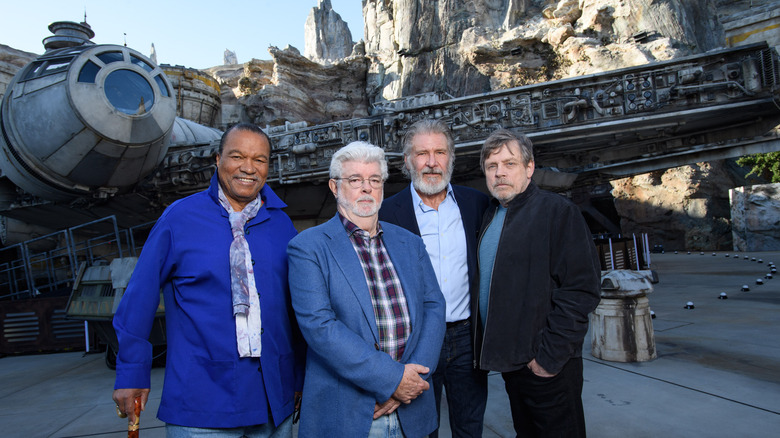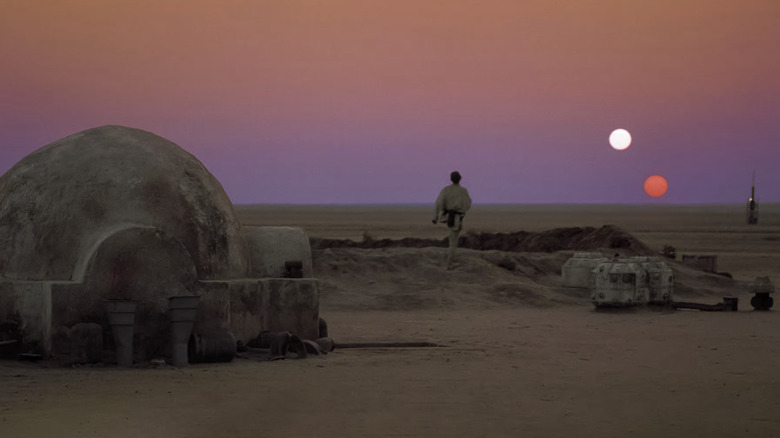How George Lucas Ended Up In The Hospital Because Of Star Wars
"Star Wars" was only the third feature film that George Lucas ever directed and it was easily more ambitious and expensive than "THX 1138" and "American Graffiti" — the $11 million budget for "Star Wars" is equal to about $65 million today. Handling that kind of money, and spending it on a film whose absurdity invited dozens of ways to fail, strained Lucas' mental wellbeing.
It didn't help that the film suffered from a production that was anything but smooth, with constant effects problems and trailing behind schedule. Not all the actors (Harrison Ford included) had faith in Lucas' vision while they were shooting it. It's a matter of filmmaking legend now how "Star Wars" didn't come together until Marcia Lucas (one of the film's three credited editors and George's then-wife) cut it into shape in her editing bay; before that, Lucas was concerned he'd bitten off more than he could chew.
In "A Long Time Ago in a Cutting Room Far, Far Away," a memoir by Paul Hirsch (another editor on "Star Wars"), he details just how stressed out Lucas was while making "Star Wars." For one, Hirsch (along with Marcia Lucas and Richard Chew) only got the editing job because Lucas canned his original editor, John Jympson, who had "apparently made his scorn for the project known," Hirsch wrote. Jympson ultimately produced a first cut that Lucas was unsatisfied by.
Lucas was so stressed by the shoot itself (split between Tunisia and Elstree Studios in England) and fear of what the movie had become that he was admitted to the hospital for chest pains. There was some concern he was having a heart attack, but thankfully not — it was just a good old-fashioned anxiety attack. Much more survivable than cardiac issues, but still not a fun experience.
Star Wars going digital
Lucas himself recounted his stress and hospitalization while making "Star Wars" in the 2022 documentary series "Light & Magic." The series, streamed on Disney+, is named after its subject: Industrial Light & Magic, the special effects company founded by Lucas in 1975 which brought forth "Star Wars" from imagination to reality.
"I ended up on my way home, flying from LA to San Francisco thinking, 'Oh my god, this isn't going to work. This is a mess! [I'll] never get to work again,'" Lucas recalled thinking. Once he was in the hospital, his doctors asked him if he was under stress ("Yeah," he answered). Since it's a director's job to manage their crew and set, the stress wasn't confined to Lucas himself. "Everybody else was panicked," Lucas said. "What if I died? People didn't even know what the movie was. Y'know it was in a million little pieces. Nobody knew what I was really doing."
The "Star Wars" prequels are often lambasted for relying on CGI and green screen instead of practical effects and physical sets like the original films. I agree this was to the films' detriment, but I understand Lucas' affinity for digital filmmaking. Making the "Star Wars" films was a never-ending series of headaches (and sometimes worse) for him. When he went back to Tunisia to shoot the Tatooine scenes for "The Phantom Menace," the bigger budget did nothing to stop sets from being destroyed.
Digital effects may be less tactile, but so long as there's still a human hand guiding them (and not an artificial one), they can be beneficial. There's nothing practical about risking your health for a movie, after all.

